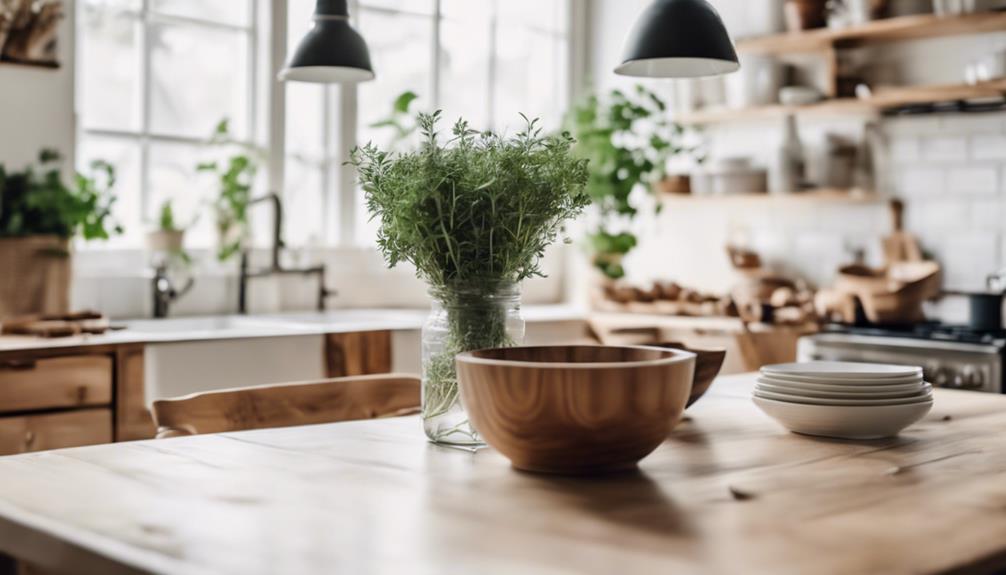You can effortlessly bring Scandinavian simplicity into your kitchen without a major renovation by incorporating a few key elements. Begin by embracing a cohesive color palette with light neutrals and gentle pastels to establish a soothing environment. Integrate natural materials such as light-toned woods and textiles crafted from cotton or linen to add warmth. Improve illumination with ample windows, sheer treatments, and adjustable fixtures to maximize natural light. Infuse decorative touches like vintage wooden bowls and botanical artwork to create a cozy and engaging atmosphere. With some thoughtful enhancements, your kitchen can exude that minimalist Nordic allure gracefully. Discover additional ideas to enhance your space with ease!
Key Elements
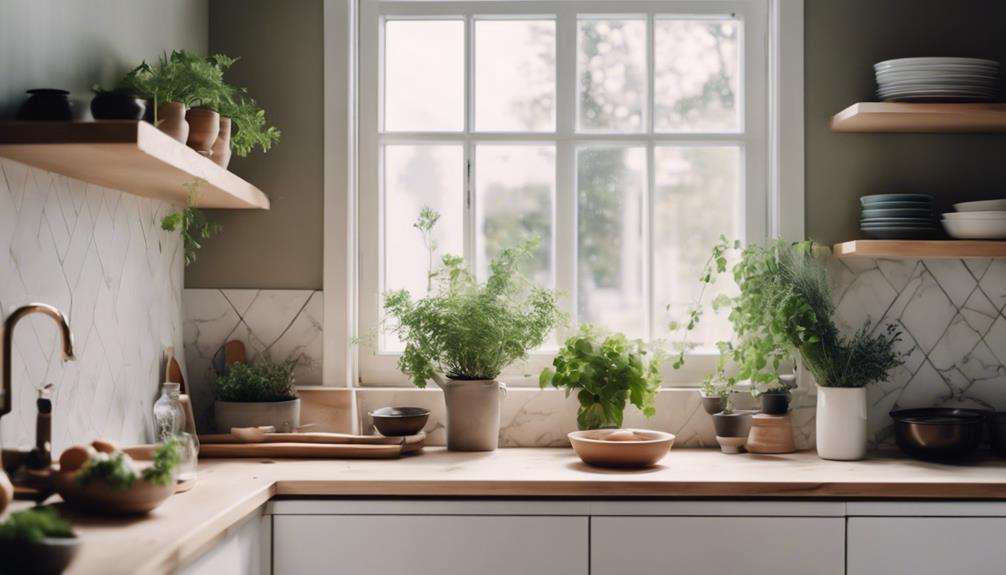
To achieve Scandinavian simplicity in your kitchen, focus on a cohesive color scheme, natural materials, and varied textures.
You'll want to create a calming atmosphere with neutral tones while incorporating elements that add warmth and depth.
Color Scheme
A minimalist color palette featuring whites, soft grays, and pastel tones instantly transforms your kitchen into a bright and airy space, embodying the essence of Scandinavian design. This color scheme highlights neutral tones that foster a serene environment, promoting a calming ambiance. By sticking to a minimalist aesthetic, you can create a cohesive look that emphasizes natural materials and clean lines.
To enhance the luminosity of your kitchen, opt for light-colored walls that maximize natural light. This approach not only creates an inviting atmosphere but also aligns with the Scandinavian principle of functionality. You can incorporate pops of color through accessories like dishware or textiles, adding visual interest while maintaining the serene vibe.
Choosing a monochromatic palette to create subtle earth tones or pastels can further emphasize tranquility, inspired by the Nordic landscape. Such a scheme allows you to connect with nature, reflecting the warmth and texture that wood finishes bring to your space.
Ultimately, this careful selection of a color scheme can bring the Scandinavian simplicity you desire into your kitchen, making it a harmonious and welcoming place.
Materials
Incorporating light-toned woods like pine or oak for your cabinetry and shelving adds warmth and a natural touch that defines Scandinavian design. These materials create a cozy, inviting atmosphere while staying true to minimalist principles.
To enhance sustainability, consider eco-friendly materials like bamboo or reclaimed wood for your countertops and accessories.
Textiles play an essential role in achieving that warm and inviting feel. Opt for natural fibers, such as cotton or linen, for tablecloths, dish towels, and cushion covers. These textiles not only add comfort but also reinforce the simplicity of the Scandinavian aesthetic.
Don't forget about hardware and fixtures—sleek metal finishes like brushed nickel or matte black will complement the clean lines of your design.
To further integrate natural elements, incorporate greenery into your kitchen with potted herbs or low-maintenance indoor plants. This not only adds a pop of color but also fosters a connection to nature.
Textures
Natural textures are essential for creating a warm and inviting kitchen, so consider adding wooden elements like butcher blocks and open shelving to enhance that connection to nature. Incorporating wooden cabinetry can bring both warmth and texture to your space, grounding it in the simplicity of the Scandinavian design philosophy.
Textiles made from natural materials like linen and cotton can add softness and comfort, perfect for kitchen towels and cushion covers. Woven baskets not only serve as storage but also introduce tactile elements that enrich the minimalist aesthetic.
To maintain a clean look while enhancing the design, opt for stone or ceramic accents, such as textured countertops or decorative dishware. These organic materials can provide depth without overwhelming the space.
Layer different textures by combining smooth finishes, like sleek cabinetry, with rougher elements, such as a rustic wooden table or a woven rug. This approach creates visual interest while ensuring your kitchen remains cohesive and stylish.
Essential Fixtures and Furniture

When it comes to essential fixtures and furniture in your kitchen, you'll want to focus on pieces that blend functionality with a sleek aesthetic.
A stainless steel faucet, integrated pull-out pantry, and under-mounted sink with a cutting board can all enhance your space while keeping it minimalist.
Let's explore how these choices can elevate your Scandinavian-inspired kitchen.
Sleek Stainless Steel Faucet
A sleek stainless steel faucet instantly elevates your kitchen's aesthetic, merging minimalist design with practical functionality. This essential fixture embodies the minimalist aesthetic of a modern Scandinavian kitchen, featuring clean lines and a handle-less design that promotes both functionality and simplicity. Its durable, corrosion-resistant surface complements the wooden cabinetry and natural materials often found in Scandinavian interiors.
Beyond just looks, a stainless steel faucet enhances your kitchen's bright and airy atmosphere. The reflective surface plays with light, making your space feel more open and inviting, which is vital during those long, dark winters. Many of these faucets also come equipped with eco-friendly features, like water-saving technology, aligning perfectly with the Scandinavian commitment to sustainability.
If you're looking to boost efficiency, consider models with integrated pull-down sprayers or touchless operation. These features not only increase convenience during meal prep but also maintain the sleek, minimalist style that defines Scandinavian design. By incorporating a sleek stainless steel faucet, you'll not only enhance your kitchen's functionality but also achieve a harmonious blend of style and practicality.
Integrated Pull-Out Pantry
Incorporating an integrated pull-out pantry not only maximizes storage efficiency but also complements the sleek aesthetic established by your stainless steel faucet, creating a cohesive Scandinavian kitchen design. This clever storage solution utilizes narrow spaces, allowing you to easily access dry goods and kitchen essentials while maintaining a streamlined look.
To adhere to the principles of Scandinavian design, consider choosing flat-panel fronts that match your existing cabinetry, ensuring visual continuity and minimalism. Adding natural wood materials, like light oak or birch, enhances warmth and texture, aligning with the organic elements celebrated in this style.
A well-designed integrated pull-out pantry can feature adjustable shelving, accommodating various item sizes while keeping everything organized. This functionality doesn't compromise aesthetics; rather, it creates a functional yet aesthetically pleasing space.
Moreover, these pull-out pantries contribute to a clutter-free environment, allowing you to conceal kitchen items and promote the serene, inviting spaces characteristic of Scandinavian design. By incorporating an integrated pull-out pantry, you'll elevate your kitchen's functionality while embracing simplicity and elegance.
Under-Mounted Sink With Cutting Board
An under-mounted sink enhances your kitchen's minimalist aesthetic while making cleanup effortless, thanks to its seamless integration with the countertop. This design choice eliminates edges that trap dirt, ensuring your space remains pristine.
When you pair your under-mounted sink with a cutting board that fits snugly over it, you maximize countertop space and create a practical food prep area, essential for maintaining a clutter-free kitchen.
Materials like stainless steel or composite for the under-mounted sink harmonize beautifully with light wood cabinetry, which is a staple of Scandinavian design. This combination not only promotes warmth but also emphasizes functionality.
Opting for a cutting board made from sustainable wood, such as bamboo or beech, aligns with the eco-friendly principles inherent in Scandinavian aesthetics.
Together, the under-mounted sink and cutting board serve practical functions while contributing to a cohesive and streamlined look. This setup reinforces the overall simplicity and functionality of your kitchen space, making it a perfect embodiment of Scandinavian design.
Embrace this minimalist approach, and enjoy a kitchen that's both beautiful and efficient.
Lighting Ideas
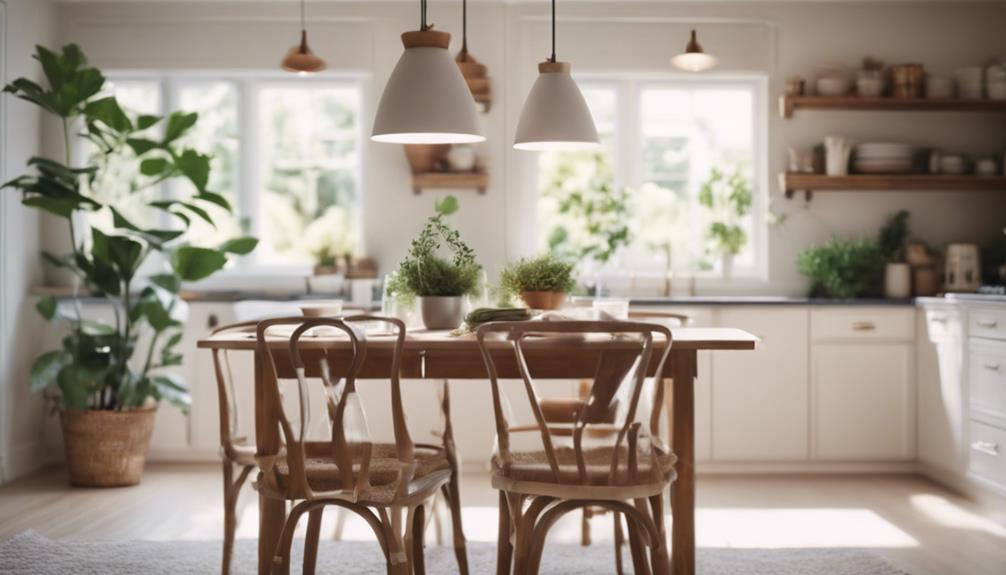
When it comes to lighting in your kitchen, think about how to maximize natural light while incorporating soft ambient LED strips.
You can also consider recessed ceiling spotlights and dimmable pendant fixtures to set the perfect mood.
These elements not only enhance functionality but also align beautifully with Scandinavian simplicity.
Soft Ambient LED Strips
Soft ambient LED strips transform your kitchen into a cozy retreat, offering warm light that enhances the minimalist Scandinavian aesthetic. By installing soft ambient LED strips under cabinets or along shelves, you create an unobtrusive glow that highlights your kitchen's design elements while fostering an inviting atmosphere. This warm, inviting light mimics natural daylight, promoting relaxation and comfort in your space.
One of the key benefits of these LED strips is their energy-efficient nature. With a lifespan of up to 50,000 hours, they align perfectly with the eco-friendly principles that define Scandinavian design. Opt for soft white or warm white LED strips, typically around 2700K to 3000K, to maintain that calming vibe.
The flexibility of soft ambient LED strips allows for creative placement throughout your kitchen. You can accentuate architectural features or highlight open shelving to showcase your favorite kitchenware without cluttering the space. This thoughtful lighting choice not only enhances the cozy atmosphere but also complements the minimalist aesthetic that Scandinavian design embodies.
Embrace the simplicity and warmth these LED strips bring, making your kitchen a true sanctuary.
Natural Light Maximization Techniques
Maximizing natural light in your kitchen not only brightens the space but also creates a seamless connection with the outdoors, embodying the essence of Scandinavian design. Start by installing large, unobstructed windows that invite sunlight, enhancing the openness of your kitchen.
To further amplify natural light, incorporate light, reflective surfaces like white cabinetry or glossy finishes, which bounce light around the room.
When it comes to window treatments, opt for sheer or light-filtering options. These allow maximum sunlight during the day while still providing privacy and softening harsh light when necessary.
Additionally, positioning mirrors strategically can help reflect light and visually expand your space, contributing to a brighter atmosphere.
You should also layer multiple lighting sources, including pendant lights and under-cabinet LED strips. This won't only complement the natural light but make certain that your kitchen remains well-lit during shorter winter days.
Recessed Ceiling Spotlights
Recessed ceiling spotlights seamlessly complement the natural light in your kitchen, enhancing the minimalist aesthetic of Scandinavian design while providing targeted illumination for your cooking and dining areas. These fixtures blend effortlessly into your ceiling, creating a sleek look that doesn't distract from the overall design.
By strategically placing recessed ceiling spotlights, you can highlight essential areas like countertops and workspaces, ensuring you have the functional lighting necessary for meal prep and entertaining. Pairing these spotlights with large windows allows for a perfect balance of natural lighting during the day and energy-efficient LED lights when the sun goes down.
Choosing energy-efficient LED recessed lights not only aligns with eco-friendly practices but also supports the sustainable materials that are vital to Scandinavian principles. Additionally, opting for dimmable recessed lighting lets you adjust the brightness to create a warm atmosphere, perfect for cozy dinners or gatherings.
Incorporating recessed ceiling spotlights into your kitchen elevates the space, achieving both aesthetic appeal and practical functionality without compromising on style. Embrace the simplicity and elegance that these lights offer to enhance your Scandinavian-inspired kitchen effortlessly.
Dimmable Pendant Light Fixtures
Dimmable pendant light fixtures are a must-have for your Scandinavian kitchen, offering versatile illumination that suits both vibrant meal prep and intimate dining experiences. By incorporating dimmable pendant lights, you can effortlessly switch from bright task lighting to softer ambient lighting, creating the perfect atmosphere for any occasion.
These fixtures often boast a minimalist design, crafted from materials like glass, wood, or ceramics, which aligns beautifully with the Scandinavian aesthetic. Their clean lines and simple forms enhance the overall look of your kitchen while keeping it functional.
When you choose dimmable LED bulbs, you not only support energy efficiency but also enjoy varying color temperatures that mimic natural light. This is especially important in Nordic design, which celebrates nature and tranquility.
Strategically placing dimmable pendant lights above your kitchen island or dining area creates a stunning focal point, contributing to the open and airy feel characteristic of Scandinavian interiors. With these lighting solutions, you can easily adapt your space to suit any mood, making your kitchen a true reflection of Scandinavian simplicity and elegance.
Decorative Elements
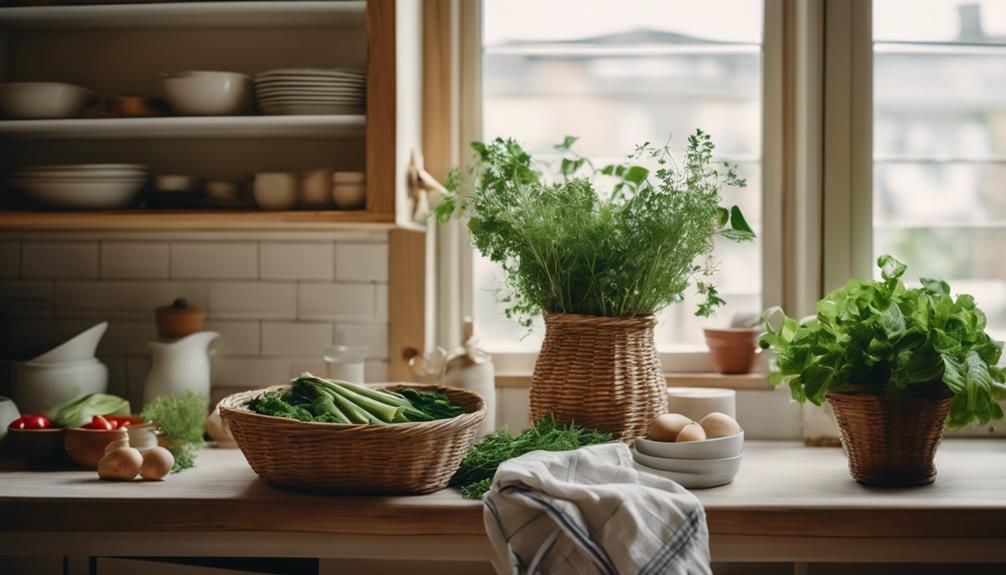
When it comes to decorative elements, think about incorporating a handcrafted ceramic vase or framed botanical wall art to add a touch of personality to your kitchen.
A vintage Scandinavian wooden bowl can serve as both a functional and eye-catching piece.
These thoughtful choices embody the simplicity and warmth of Scandinavian design, enhancing your space without overwhelming it.
Handcrafted Ceramic Vase
Handcrafted ceramic vases bring a touch of Scandinavian simplicity to your kitchen, showcasing organic forms and muted colors that enhance the space without overpowering it. These vases, often crafted in neutral colors like soft whites, grays, and pastels, align perfectly with a minimalist approach, promoting a serene environment.
You can place these vases on open shelving or countertops, using them to display seasonal flowers or greenery. This not only adds vibrancy but also creates a direct connection to nature, making your kitchen feel more inviting.
The tactile quality of handcrafted ceramics introduces warmth and texture, contributing to a cozy atmosphere that's essential in any home.
Framed Botanical Wall Art
Framed botanical wall art instantly elevates your kitchen's decor, bringing a breath of nature indoors while adhering to the Scandinavian principles of simplicity and functionality. To maintain a cohesive look, opt for prints that feature delicate illustrations or photographs of local flora. This choice enhances the calming atmosphere typical of Scandinavian interiors, all while embracing a neutral color palette that complements minimalist design.
When selecting frames, go for options made from natural wood or light-colored materials. This guarantees they align seamlessly with the overall warmth and texture of your kitchen. Incorporating a series of small botanical prints arranged in a grid formation can create an inviting focal point without overwhelming the space—perfectly embodying the 'less is more' principle.
Additionally, consider using eco-friendly or sustainably sourced materials for both the artwork and frames. This not only supports your aesthetic but also aligns with the Scandinavian commitment to environmental consciousness.
Vintage Scandinavian Wooden Bowl
Incorporating a vintage Scandinavian wooden bowl into your kitchen decor adds a rustic charm that beautifully complements the botanical art you've chosen. These bowls, often crafted from light-toned woods like birch or pine, showcase natural grain and texture, enhancing the warmth and organic feel of your space. Not only do they serve as functional kitchenware, but they also act as striking decorative elements.
You can fill a vintage Scandinavian wooden bowl with seasonal fruits or decorative items, effortlessly enhancing your minimalist aesthetic while keeping your kitchen clutter-free. This dual-purpose use reflects the Scandinavian design principle of sustainability, as many vintage pieces are made from reclaimed wood and are built to last for generations.
Displaying your bowl on open shelving or countertops highlights its beauty and promotes the cozy concept of hygge. This invites a sense of comfort into your kitchen, making it a welcoming space for family and friends.
Flooring
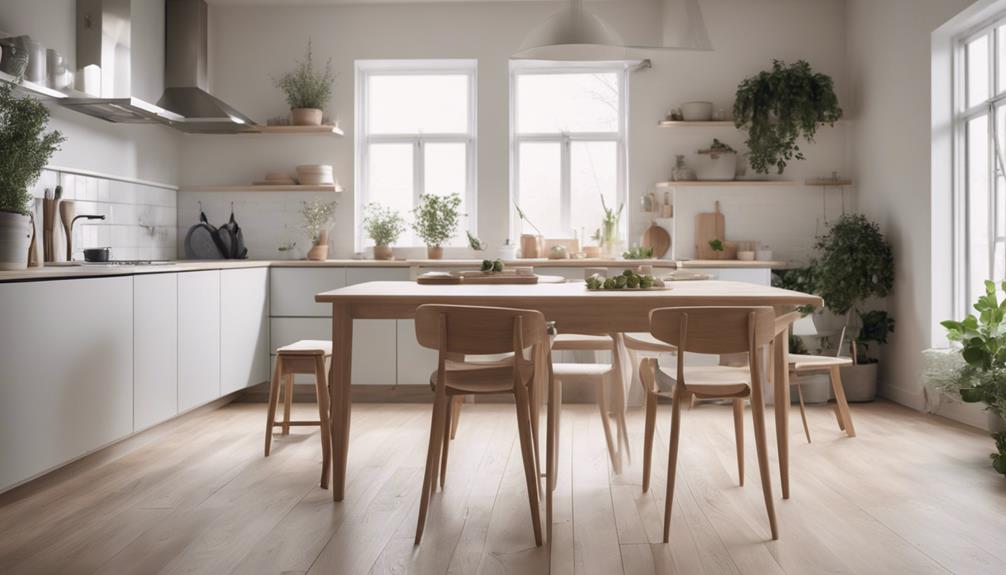
When choosing flooring for your Scandinavian kitchen, consider light oak hardwood planks for their warmth and brightness.
Alternatively, textured concrete finishes can offer a modern, industrial touch that still feels inviting.
Whitewashed pine floorboards also provide a timeless, airy look that beautifully complements a minimalist aesthetic.
Light Oak Hardwood Planks
Have you considered how light oak hardwood planks can transform your kitchen into a bright and inviting space? In Scandinavian kitchen design, light oak is a popular choice for its natural warmth and ability to enhance the lightness of your home. The soft, light tones not only create a welcoming atmosphere but also pair beautifully with white and pastel color palettes, which are staples in this style.
Light oak flooring features a subtle grain pattern that adds just the right amount of texture without detracting from the minimalist aesthetic that defines Scandinavian design. You'll appreciate how this flooring can withstand heavy foot traffic while still looking stunning over time, making it a practical option for your busy kitchen.
Choosing light oak is also a sustainable choice, aligning with the eco-friendly principles embraced in Scandinavian culture. By selecting this flooring, you're not just elevating your kitchen's look; you're making a conscientious decision for the environment.
Textured Concrete Flooring Finish
Light oak hardwood planks create a warm foundation, but textured concrete flooring can elevate your kitchen's modern appeal while maintaining that Scandinavian simplicity. This durable and low-maintenance option embodies a minimalist aesthetic, ensuring your space is both functional and stylish.
With various finishes available, like polished or matte, you can achieve a clean, modern look that enhances the overall brightness and spaciousness of your kitchen. Textured concrete flooring is also an eco-friendly choice, often incorporating recycled aggregates or low-VOC sealers, reflecting the sustainability principles central to Scandinavian design.
Its ability to retain heat makes it a practical option, perfect for creating a cozy atmosphere during those chilly winters. To achieve a harmonious balance characteristic of Scandinavian interiors, pair textured concrete with natural wood elements and soft textiles.
This combination not only elevates your kitchen's design but also adds warmth and comfort, ensuring the space feels inviting. By choosing textured concrete, you're not just opting for a flooring material; you're embracing a lifestyle that values simplicity, functionality, and sustainability.
Whitewashed Pine Floorboards
Whitewashed pine floorboards bring a fresh, airy vibe to your kitchen while retaining the inviting warmth of natural wood. This flooring choice perfectly embodies Scandinavian style, enhancing the light, open feel that many seek in their homes. The whitewashing process allows the wood's natural grain to shine through, creating a soft, muted finish that amplifies light reflection and brightens your space.
As you embrace a minimalist color palette, the light tones of whitewashed pine harmonize seamlessly with your cabinetry and decor, contributing to a cohesive look. Plus, pine is a durable material, ensuring that your floors can withstand the hustle and bustle of daily kitchen life.
The soft texture of whitewashed pine not only looks beautiful but also fosters a cozy atmosphere, making your kitchen feel welcoming and comfortable. With its sustainable properties, this flooring aligns with eco-friendly principles, allowing you to enjoy both style and responsibility.
How Can I Incorporate Scandinavian Design Elements Into Different Rooms in My Home?
Incorporating Scandinavian design elements into different rooms in your home can create a sense of simplicity and functionality. In the living room, add clean lines and light colors for a minimalist look. In the bedroom, use natural materials and cozy textiles for a cozy, inviting feel. For a Scandinavian home office productivity, incorporate plenty of natural light, minimalistic furniture, and functional storage solutions to create a productive and inspiring workspace.
Conclusion
By incorporating Scandinavian simplicity into your kitchen, you can create a serene and functional space without the need for a full remodel.
Focus on key elements like essential fixtures and furniture, choose the right lighting to enhance the atmosphere, and add decorative touches that reflect your style.
Finally, consider your flooring choices to tie everything together.
With these tips, you'll enjoy a fresh, minimalist kitchen that feels both inviting and practical.
